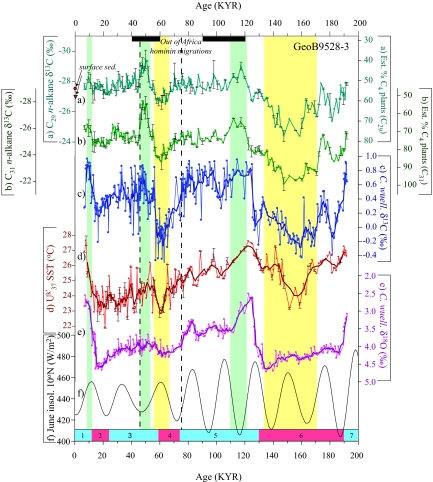Fig. 2.
Geochemical records from GeoB9528-3. In traces c–e, the thick line represents the smoothed data (five-point running mean). In traces a, b, and d, the error bars represent the standard deviation of replicate analyses. All isotope data are reported in standard delta notation (‰) against the VPDB standard. The black bars at the top of the graph indicate documented human migrations out of Africa (23, 24). The vertical dashed lines indicate periods of major extinctions and turnovers of hominin populations at ≈75 and ≈45 ka (34). Wet intervals during the AHP, within MIS 3 and during MIS 5 are indicated by green shading. Arid intervals during MIS 6 and MIS 4 are indicated by yellow shading. The bar at the bottom indicates MIS 1–7. Trace a shows carbon isotope (δ13C) values of the C29 n-alkane. On the right side of the graph, the estimated %C4 plants is shown for the C29 n-alkane, based on a binary mixing model assuming end-member values of −34.7‰ and −21.4‰ for C3 and C4 vegetation, respectively. On the left side of the graph, δ13C values of C29 n-alkanes in surface sediments collected in the vicinity of GeoB9528-3 are shown. The red circle represents a δ13C value of −27.5‰ for site GIK16757-1 (8°58.60 N, 16°56.48 W) and the red triangle represents a δ13C value of −27‰ found at sites GIK16405-1 (12°25.37 N, 21°25.37 W) and GIK16408-2 (9°47.88 N, 21° 27.24W) (11). Trace b shows δ13C values of the C31 n-alkane. On the right side of the graph, the estimated %C4 plants is shown for the C31 n-alkane, based on a binary mixing model assuming end-member values of −35.2‰ and −21.7‰ C3 and C4 vegetation, respectively. Trace c shows the δ13C of the benthic foraminifer C. wuellerstorfi. The precision of these measurements is ± 0.05‰ based on replicates of an internal limestone standard. Trace d shows alkenone (U37k') SST reconstruction for GeoB9528-3 (see SI Text for methods). Trace e shows the δ18O of the benthic foraminifer C. wuellerstorfi. The precision of these measurements is ± 0.07‰ based on replicates of an internal limestone standard. Trace f shows June insolation at 10°N (14).

